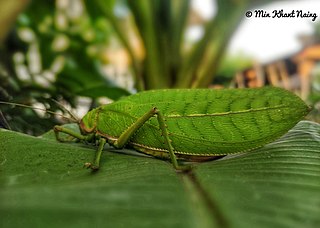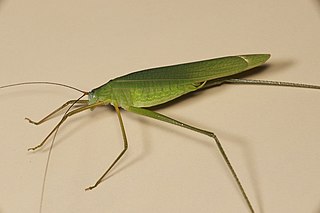
Anostostomatidae is a family of insects in the order Orthoptera, widely distributed in the southern hemisphere. It is named Mimnermidae or Henicidae in some taxonomies, and common names include king crickets in Australia and South Africa, and wētā in New Zealand. Prominent members include the Parktown prawn of South Africa, and the giant wētā of New Zealand.

Gryllacrididae are a family of non-jumping insects in the suborder Ensifera occurring worldwide, known commonly as leaf-rolling crickets or raspy crickets. The family historically has been broadly defined to include what are presently several other families, such as Stenopelmatidae and Rhaphidophoridae, now considered separate. As presently defined, the family contains two subfamilies: Gryllacridinae and Hyperbaeninae. They are commonly wingless and nocturnal. In the daytime, most species rest in shelters made from folded leaves sewn with silk. Some species use silk to burrow in sand, earth or wood. Raspy crickets evolved the ability to produce silk independently from other insects, but their silk has many convergent features to silkworm silk, being made of long, repetitive proteins with an extended beta-sheet structure.

The subfamily Pseudophyllinae contains numerous species in the family Tettigoniidae, the katydids or bush crickets. Sometimes called "true katydids", together with the crickets of suborder Ensifera, they form part of the insect order Orthoptera which also contains grasshoppers.

The Phaneropterinae, the sickle-bearing bush crickets or leaf katydids, are a subfamily of insects within the family Tettigoniidae. They are also known as false katydids or round-headed katydids.

Gryllacridinae is an Orthopteran subfamily in the family Gryllacrididae.

Larnaca is a genus of Asian orthopterans, sometimes known as 'leaf-folding crickets', in the subfamily Gryllacridinae and tribe Gryllacridini. Species have been recorded from: southern China, Indochina and western Malesia.

Mecopodinae are a subfamily of bush crickets found in western South America, sub-Saharan Africa, and Asia. In Asia, the distribution includes India, Indochina, Japan, the Philippines, and Malesia to Papua New Guinea and Australasia, including many Pacific islands.

Agraeciini is a large tribe of bush crickets or katydids in the conehead subfamily, Conocephalinae.
Capnogryllacris is a genus of leaf-rolling crickets in the subfamily Gryllacridinae and tribe Capnogryllacridini, erected by Heinrich Hugo Karny in 1937. Species are found in Far East and South Asia; two other of Karny's genera were previously placed here: Borneogryllacris and Marthogryllacris.
Lipotactes is a genus of bush crickets found in southern China, Indo-China and Malesia; it is the only living genus in the subfamily Lipotactinae.

Elimaea is a large genus within Tettigoniidae, the bush cricket or katydid family. Species in this genus are found in India, southern China, Indo-China and Malesia.
Anabropsis is a genus of king crickets in the tribe Anabropsini. They are found tropical areas of the Americas, Africa and Asia.
Rhaphidophora is the type genus of camel crickets in the tribe Rhaphidophorini.

Hyperbaeninae is a subfamily of Orthopterans, sometimes known as 'leaf-folding crickets' in the family Gryllacrididae; Hyperbaenus ensifer is the type species. The known distribution includes tropical: central and southern America, Africa and mainland Asia to Australasia.
Phryganogryllacris is a genus of Asian Orthopterans, sometimes known as "leaf-folding-" or "raspy-crickets", in the subfamily Hyperbaeninae and tribe Phryganogryllacridini. Species have been recorded from: India, China, Indochina, Malesia, through to New Guinea.
Neanias is a genus of Orthopterans, sometimes known as 'leaf-folding crickets' in the subfamily Gryllacridinae and tribe Gryllacridini. The recorded distribution is: Indian subcontinent, Japan, Hainan, Indochina, and western Malesia (Sumatra).

Diaphanogryllacris is a genus of Orthopterans, sometimes known as 'leaf-folding crickets' in the subfamily Hyperbaeninae and tribe Capnogryllacridini. The recorded distribution is: the Indian subcontinent, China, Indochina, western Malesia up to Sulawesi.
Eugryllacris is a genus of Orthopterans, sometimes known as 'leaf-folding crickets' in the tribe Gryllacridini. The recorded distribution is: the Indian subcontinent, China, Korea, Japan, Indochina, western Malesia up to the Maluku Islands.
Anancistrogera is a genus of Orthopterans, sometimes known as 'leaf-folding crickets' in the tribe Gryllacridini and typical of the newly erected genus group Anancistrogerae. The recorded distribution is: Sri Lanka, Thailand and western Malesia.
Lyperogryllacris is a genus of Orthopterans, sometimes known as 'leaf-folding crickets' in the tribe Gryllacridini. The recorded distribution is from Indochina, and western Malesia.











